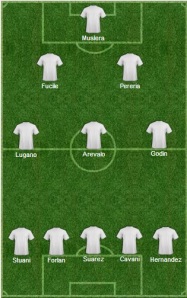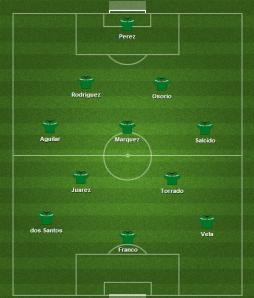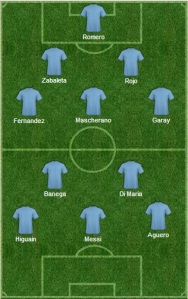Tagged: Gaston Ramirez

1930 World Cup Modernised: The Tactics of the Finalists in Uruguay
Without trying to sound as patronising as possible towards you, the reader, football was a lot different 84 years ago. Fitness and safety conditions were not seen as paramount concerns and the structure of your average team differed substantially to the tactically precise vision of the modern beautiful game. In the 1930 World Cup, an average of 3.88 goals were scored per match and this was mainly due to the emphasis on attack. Teams often lined up in a 2-3-5 or 2-3-2-3 formation, with five forwards and five defensively minded players taking their place outfield. It wasn’t until after the 1960’s that teams started to care more about not conceding as line ups contained a bank of four playing in defence. In the 1962 World Cup in Chile, there was only an average of 2.76 goals per game, contrasting heavily with the 5.38 average recorded in 1954.
In the modern era, defensive abilities are considered more of an art form and coaches believe that a solid back line is the foundation to building a successful starting line-up. The pessimistic approach of 21st century manager’s seems to be that if you concede first, you’re inevitably going to be chasing the game, whilst in the early 1900’s the underlying ethos of ‘scoring more than your opponent’ seemed to be the correct course of action in order to be victorious. Liverpool tried to quasi-implement this style of play during the 2013/2014 Premier League campaign and were almost successful in winning a domestic title, but focusing mainly on your strikers and hoping your defensive frailties aren’t exposed is destined to fail in an age where scouts, managers and pundits can recognise the strengths and weaknesses of every single team after observing just a few of their matches.
In the 1930 World Cup final, Uruguay and Argentina were the teams to watch having comprehensively disposed of Yugoslavia and USA in the semis with both countries recording 6-1 victories. Guillermo Stabile was the key player for La Albiceleste, netting a brace in that particular match and also going onto score a goal in the final. For the Uruguayans, Pedro Cea caused the most problems, scoring four goals in the semi and final collectively. Both of these individuals played on the attacking front line for their respective nations, and it was this front line alone that was responsible for scoring. Presumably, the defensive players in each line-up were instructed to stick to their defensive duties: no running up for the corners or anything silly like that. The final finished 4-2 to the hosting nation and remains the joint-second highest scoring World Cup final to date, with only Brazil’s 5-2 triumph over Sweden in 1958 recording more goals. What a final that must have been to watch for the neutral.
But let’s imagine a world where attacking minded play and entertaining football were the main points of discussion in the manager’s team talk before a big game. Let’s imagine that the 2-3-5/2-3-2-3 formations are still alive in mainstream football in 2014. I wonder what sort of line ups the Uruguayans and Argentinians would have put out should they meet in the semi-final of this year’s World Cup (which is quite a realistic possibility). In the traditional formation, it was the full backs who played deepest (thus why they are normally awarded the number two/three shirt number) with the three centre-backs playing in front of them. The attackers could either be set up in a simple line of five or as a two and a three. Argentina chose the latter of these set ups with Uruguay having five outright attackers including two wingers. 84 years later but with the same structure in place, these are probably what the starting XI’s would have resembled…
URUGUAY
The amount o f attacking minded players that Uruguay have in their squad means that fielding this XI will be fairly simple for Oscar Tabarez. Suarez, Cavani and Forlan will be the main goal scorers while Abel Hernandez and Christian Stuani will have access to the wings in order to set up chances for the trio. Diego Lugano will be in his element as part of the back five since he could move about the pitch in an indolent manner whilst Egidio Arevelo can slot in at the back easily as a natural defensive midfielder and play long balls into the strikers. The full backs should be comfortable enough playing in a more defensive role as well, but the goalkeeper would need to be on top form to prevent conceding to Messi & co. With a lack of midfield players required, Gaston Ramirez and Walter Gargano would probably not make the starting line up but the stability of the defence along with Hernandez and Stuani dropping back means that they should be able to cope.
f attacking minded players that Uruguay have in their squad means that fielding this XI will be fairly simple for Oscar Tabarez. Suarez, Cavani and Forlan will be the main goal scorers while Abel Hernandez and Christian Stuani will have access to the wings in order to set up chances for the trio. Diego Lugano will be in his element as part of the back five since he could move about the pitch in an indolent manner whilst Egidio Arevelo can slot in at the back easily as a natural defensive midfielder and play long balls into the strikers. The full backs should be comfortable enough playing in a more defensive role as well, but the goalkeeper would need to be on top form to prevent conceding to Messi & co. With a lack of midfield players required, Gaston Ramirez and Walter Gargano would probably not make the starting line up but the stability of the defence along with Hernandez and Stuani dropping back means that they should be able to cope.
ARGENTINA
The Argentina XI seems more organised and manager Alejandro Sabella will probably appreciate the balance between solid defence and electrifying attack. The deadly quartet of Di Maria, Higuain, Messi and Aguero would have attacking freedom whilst Lavezzi is more than capable of making an appearance from the bench to replace Banega if they require more goal-scoring prowess (which would be unlikely). In the defence, Mascherano can slot into a centre-half role that he has played before at Barcelona whilst Garay and Fernandez are strong in the air and can prevent any long passes finding their way to the Uruguay attack. Zabaleta might be frustrated with the lack of opportunities to go forward in an inflexible formation but will still play a vital part in defence. There is no space for Martin Demichelis or Fernando Gago unfortunately.
PREDICTION: Uruguay 2-3 Argentina
Of course, there are some inevitable consequences of fielding this formation in a 2014 football match. The fact that a rigid defence playing deep inside their own half will be any quick-paced striker’s dream would see them being bombarded with attack after attack for a full 90 minutes. The offside trap would be difficult to play with deep lying defenders and thus both teams will be inviting pressure on themselves. Finally, especially in the case of the 2-3-5 formation, the gaping space between defence and attack would be exploited and the opposing side would retain a majority of a position in the midfield. Whilst footballers weren’t strictly considered to be ‘athletes’ in the 1930’s, they certainly are now. Pace and agility are the new meat and drink for the average player, especially in the Premier League (where you will find many top class World Cup players week in, week out).
However, with the addition of the attacking full back now common in modern football in order to try and gain a advantage via the wings, some may argue that the basic structure of the 2-3-2-3 formation used by Argentina is still alive today in different variations. In 2010, Jonathan Wilson examined the introduction of 2-3-2-3 in teams such as Barcelona and Mexico, but instead of relying on full backs for their defensive duties, they now operate in almost contradictory fashion.
The attacking full-back provides not merely auxiliary attacking width but is the basic source of width as the wide forwards turn infield
Although the idea of either the right back or left back pushing up the pitch to lend support to the attack is not exactly a new phenomenon, using both full backs in offensive positions simultaneous is reminiscent of pre-1960 tactics. In this version however, the centre-backs lie deepest and the full backs would slot alongside a defensive midfielder in the preliminary stages of the game, but then would advance forward to link up with wingers while their team was attacking. Here is how Mexico lined up against England during a friendly in 2010.
 In this formation, Salcido and Aguilar are the full backs, but move forward when the team has possession. This means that Rafael Marquez has to move back in between the centre backs in order to form a solid defence. When England was attacking, Salcido and Aguilar moved back into their original defensive positions while Marquez provided cover in front of the back four. This provides a fairly stable 4-1-2-3 formation, which transforms into 3-4-3 when the Mexican full backs are advancing. These tactics are based on the positions of the original 2-3-2-3 but with added dynamics in order to cope with the pace of modern football.
In this formation, Salcido and Aguilar are the full backs, but move forward when the team has possession. This means that Rafael Marquez has to move back in between the centre backs in order to form a solid defence. When England was attacking, Salcido and Aguilar moved back into their original defensive positions while Marquez provided cover in front of the back four. This provides a fairly stable 4-1-2-3 formation, which transforms into 3-4-3 when the Mexican full backs are advancing. These tactics are based on the positions of the original 2-3-2-3 but with added dynamics in order to cope with the pace of modern football.
Did this work? No. England won the match 3-1. Although Mexico were impressive in attack, they were wasteful with their opportunities. Conceding goals from set pieces was their main undoing, which shows that in order for the 2-3-2-3 to work, you need aggressive defenders in the air.
It remains to be seen if this original style of formation is to be used successfully again in the 21st century, but provided it is implemented by a side that contains attacking full-backs, pacey forwards and organised defenders, it can become as successful as it was during those early years of World Cup football.
